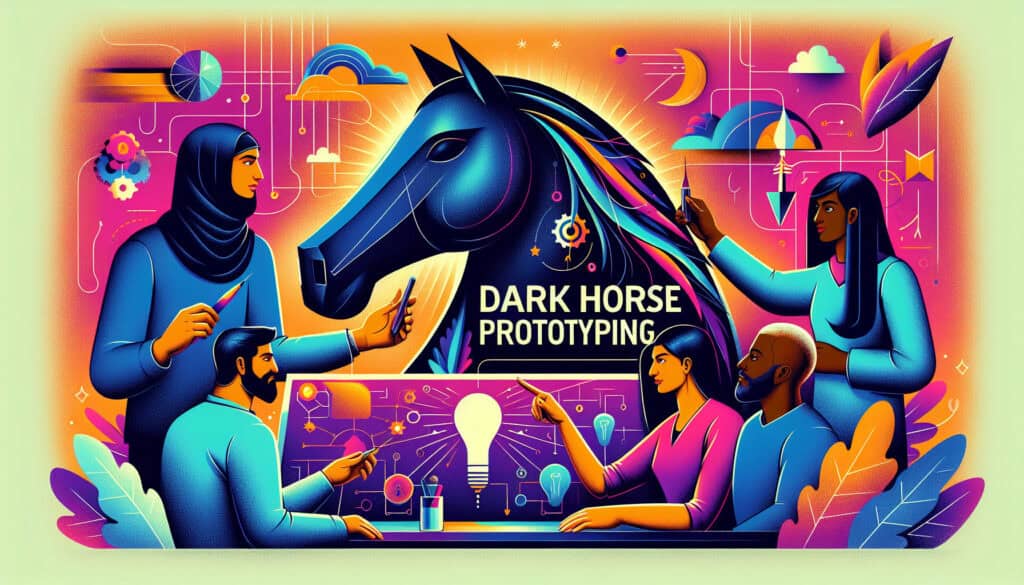A technique where a team deliberately develops a provocative, unconventional, and seemingly unworkable prototype alongside more conservative options.
- Metodologías: Ingeniería, Calidad
Dark Horse Prototyping

Dark Horse Prototyping
- Metodología ágil, Lluvia de ideas, Creatividad, Colaboración multifuncional, Pensamiento de diseño, Innovación, Creación de prototipos, Creación rápida de prototipos, Diseño centrado en el usuario
Objetivo:
Cómo se utiliza:
- In an innovation process, a 'dark horse' or 'wild card' idea is prototyped to challenge assumptions, push creative boundaries, and explore the fringes of the problem space, even if it's not expected to be the final solution.
Ventajas
- Stretches the team's creativity and pushes them beyond safe solutions; can lead to breakthrough innovations by exploring radical ideas; helps to clarify the boundaries of the solution space.
Contras
- The prototype is often impractical and has a low chance of direct success; can be seen as a waste of resources if the purpose is not understood; may be too abstract for some team members.
Categorías:
- Ideación, Diseño de producto
Ideal para:
- Challenging assumptions and sparking innovation by prototyping a radical, high-risk, and unconventional idea.
Dark Horse Prototyping finds its value in diverse sectors such as automotive design, consumer electronics, and dispositivo médico development, where teams are encouraged to break free from traditional paradigms and explore uncharted territories of product conceptualization. This methodology is particularly relevant during the early phases of innovation projects when teams are ideating potential solutions, as it allows them to formulate and visualize unconventional concepts that may initially seem impractical or risky. Participants often include cross-disciplinary teams comprised of designers, engineers, marketers, and end-users, ensuring diverse viewpoints that challenge established norms. By creating tangible representations of these ‘wild card’ ideas, organizations can facilitate discussions that refine understanding of the problem space and identify potential barriers to innovation. Companies like IDEO and Google X have successfully utilized this methodology to experiment with ideas like driverless cars and advanced robotics, showing how redefining the boundaries of what is possible can lead to technological breakthroughs. By encouraging a culture that values radical thinking, Dark Horse Prototyping becomes a platform for inspired creativity, propelling teams to interrogate their assumptions and discover innovative pathways that conventional approaches might overlook. This method demonstrates that even ideas initially perceived as impractical can serve as catalysts for discussion, ideation, and, eventually, development of products that address futurist needs and markets.
Pasos clave de esta metodología
- Identify a 'dark horse' idea that diverges from conventional solutions.
- Develop a low-fidelity prototype to visualize the concept quickly.
- Conduct rapid testing with users to gather immediate feedback.
- Analyze feedback to understand user perceptions and potential challenges.
- Iterate on the prototype based on user input, refining the idea further.
- Explore adjacent concepts that may emerge during prototype iterations.
- Document findings to inform future design directions and innovation strategies.
Consejos profesionales
- Utilize scenario planning techniques to envision extreme use cases and their implications on the problem space.
- Engage diverse stakeholder perspectives during prototyping sessions to uncover hidden assumptions and sesgos.
- Implement rapid iteration cycles to refine dark horse concepts based on real-time feedback and exploration.
Leer y comparar varias metodologías, recomendamos el
> Amplio repositorio de metodologías <
junto con otras más de 400 metodologías.
Sus comentarios sobre esta metodología o información adicional son bienvenidos en la dirección sección de comentarios ↓ , así como cualquier idea o enlace relacionado con la ingeniería.
Contexto histórico
1949
1950
1950
1960
1960
1960
1960
1940
1950
1950
1958
1960
1960
1960
1960
(si se desconoce la fecha o no es relevante, por ejemplo "mecánica de fluidos", se ofrece una estimación redondeada de su notable aparición)















Publicaciones relacionadas
Calculadora de METS a calorías
Metaanálisis
Asignación de mensajes
Diagramas de modelos mentales
Fuerzas de empuje y tracción máximas admisibles
Planificación de necesidades de material (MRP)